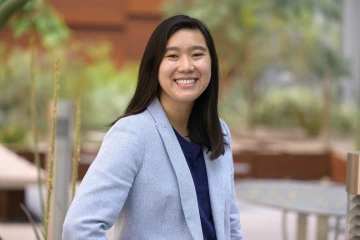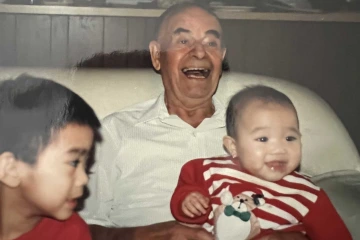Solving Alzheimer’s precision medicine questions with data
A childhood spent around older adults battling diseases including Alzheimer’s fueled Coco Tirambulo's desire to find new precision medicine treatments.

(From left) Roberta Brinton, PhD, director of the Center for Innovation in Brain Science at the University of Arizona Health Sciences, and doctoral student Coco Tirambulo are leveraging data science to find an early intervention that could help people who have an increased risk of getting Alzheimer’s disease.
Photo by Kris Hanning, UArizona Health Sciences Office of Communications
Coco Tirambulo’s journey into the complexities of neurodegenerative diseases was not borne solely in a lab. It stemmed from a childhood surrounded by the love, empathy and the realities of aging.

Coco Tirambulo’s passion for caring for older adults was shaped by both her heritage as a Filipino American and the care home operated by her parents.
Photo by Kris Hanning, UArizona Health Sciences Office of Communications
Her parents, who immigrated to the United States from the Philippines, operated assisted living care homes in Tucson. That was where Tirambulo witnessed firsthand the effects of dementia, Alzheimer’s disease and other age-related conditions.
“It was a very nurturing environment, like having many grandparents, aunts and uncles around,” said Tirambulo, whose actual grandparents stayed in the Philippines. “When I was growing up there, I had no idea that a lot of them had chronic illnesses. But as I grew older, that’s what led me to go into the health sciences because, as a Filipino American, we have the mindset that we care for elders as they grow older.”
Tirambulo’s quest to help people at risk of Alzheimer’s and other neurodegenerative diseases brought her to the University of Arizona Health Sciences Center for Innovation in Brain Science, where she is part of the Translational Research in Alzheimer’s Disease and AD-Related Dementias, or AZ-TRADD, program.
Tirambulo, a third-year MD/PhD student at the UArizona College of Medicine – Tucson, is drawing on skills acquired through a UArizona Health Sciences Data Science Fellowship to look at the Alzheimer’s gene, Apolipoprotein E, to predict who might get the disease and how they might respond to treatment. This could lead to earlier diagnoses, more effective treatment options and a better quality of life for people with Alzheimer’s disease.
“Coco is going into the data and asking precision medicine questions that could help people with an increased risk of Alzheimer’s: Can the data help lead us to an early intervention that could lower the risk factor for a person long before the disease develops?” said Roberta Diaz Brinton, PhD, director of the Center for Innovation in Brain Science and a Regents Professor of pharmacology.
A foundation for research

“Uncle Russ” moved into the Tirambulo’s care home one week before Coco Tirambulo was born. She and her brother, Angelo (left), considered Russ a best friend while growing up.
Photo courtesy of Coco Tirambulo
After graduating from high school, Tirambulo left Tucson for Brandeis University in Massachusetts, where she completed a Bachelor of Science in Biology. She returned to Tucson and, in 2018, began what will eventually become a 10-year odyssey at the UArizona Health Sciences as she seeks to improve patient care and clinical outcomes, especially for older adults.
Before medical school was even on her radar, Tirambulo obtained two master’s degrees: one in epidemiology from the UArizona Mel and Enid Zuckerman College of Public Health and another in cellular and molecular biology as part of the Pre-Medical Admissions Pathway at the UArizona College of Medicine – Tucson. At the same time, she worked as a research specialist at the Arizona Center on Aging.
“It wasn’t until I was in college that I decided medical school could be a way of being a forever student to give back to the community I grew up around,” Tirambulo said. “The Pathways program was a pipeline that made that possible for me. I was doing my master’s in epidemiology and learning about broader health care problems at the same time I was learning how to design experiments. And I was very fortunate to gain a lot of research mentorship through the Center on Aging. That’s where I built up my scientific acumen of asking questions, and I was able to contribute to publications and exciting research collaborations.”
Identifying the risk factor
In 2010, scientists knew of just 10 genetic areas associated with Alzheimer’s disease. Today, there are more than 80, including the apolipoprotein E, or APOE, gene. APOE helps make a protein that carries cholesterol and other types of fat in the bloodstream. Research has shown that when this process is disrupted, it can contribute to the development of Alzheimer’s disease.
“She understands that when one person in the family has Alzheimer’s, the whole family has Alzheimer’s.”
—Roberta Brinton, PhD
APOE comes in several forms, called alleles, and some of these alleles are better at transporting fats than others. Some research suggests that APOE e2 and e3 may provide some protection or have a neutral effect on the development of Alzheimer’s. APOE e4 increases risk for Alzheimer’s and is associated with an earlier age of disease onset in certain populations. While inheriting APOE e4 increases a person’s risk of developing Alzheimer’s, some people with an APOE e4 allele never develop the disease.
“Is the APOE e4 protein a driver of the Alzheimer’s disease pathology? Some people might say yes or no, but it’s definitely a risk factor,” Brinton said. “It may not be an absolute, but if someone develops Type 2 diabetes and also is an APOE e4 carrier, now all of a sudden, you’ve got two risk factors instead of one. That makes APOE e4 important for us to identify in people and investigate as a potential target for intervention.”
Turning data into drug development
A stubborn reality for researchers including Brinton and Tirambulo is that the prevalence and risk associated with genetics variants such as APOE e4 is not the same across all population groups. Additionally, collecting or accessing data from these populations is a monumental task.
Through the AZ-TRADD program, Tirambulo is able to access valuable data from the Alzheimer’s Disease Research Center in Wisconsin. The center has a large and diverse dataset of people who carry the APOE gene, providing Tirambulo with ample data to compare and contrast within population groups.

Much of Tirambulo’s research involves using data science techniques to identify potential drug targets for investigation.
Photo by Kris Hanning, UArizona Health Sciences Office of Communications
Identifying commonalities provides Tirambulo with subsets of at-risk patient profiles she can explore for potential drug development. Ultimately, she hopes to find evidence that APOE e4 could be a novel therapeutic target to help lower a person’s risk of Alzheimer’s development.
“When I find commonalities in the data, I want to know what makes a person able to respond to a certain drug versus to not respond. From there, I’m applying it to other people that have similar profiles,” Tirambulo said. “The goal is that if this works for this person, this can work for you. And then if it works for you, then that helps everyone have a better quality of life.”
Presently, there is no drug that targets APOE e4. Brinton believes there could a way to target APOE e4 specifically or perhaps develop a drug that molecularly transforms APOE e4 into APOE e3, one of the alleles that has a neutral effect on Alzheimer’s development.
“Imagine if you could begin this precision medicine early intervention to change the trajectory of a person from being a high risk to a low risk, and it could be done through therapeutic interventions in midlife, long before their disease develops,” Brinton said.
Tirambulo is on track to complete her MD/PhD in 2028. She envisions a future where there are treatments and even a cure for the disease that effects so many.
“Coco is one of the latest and greatest to come through our training program,” Brinton said. “Through her experiences growing up, she understands that when one person in the family has Alzheimer’s, the whole family has Alzheimer’s. That perspective inspires all of us.”
Experts
Roberta Diaz Brinton, PhD
Director, Center for Innovation in Brain Science, UArizona Health Sciences
Professor, Department of Pharmacology, College of Medicine – Tucson
Professor, Department of Neurology, College of Medicine – Tucson
Professor, Evelyn F. Mcknight Brain Institute
Professor, Department of Psychology, College of Science
Professor, Department of Pharmacology and Toxicology, R. Ken Coit College of Pharmacy
Professor, Clinical Translational Sciences, College of Health Sciences
Member, BIO5 Institute
Contact
Blair Willis
UArizona Health Sciences Office of Communications
520-419-2979, bmw23@arizona.edu

